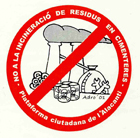Győr needs a new monster?

 Articles about incineration from the former Hungarian versions of Waste Diver (Kukabúvár)
Articles about incineration from the former Hungarian versions of Waste Diver (Kukabúvár)
Summer 2003 – Autumn 2004
In Győr, which is the biggest town of Western Hungary the municipality decided not long ago that a regional waste management facility has to be established near the city. It came true only in the court procedure that in reality it was a landfill with waste separation and treatment which can integrate a big capacity incinerator later on. According to the plans the facility can accept 1.000 000 m3 waste form 130 municipalities over 40 years.
According to the Reflex Association (member of HuMuSz) the territory is not suitable for the implementation of the regional waste landfill site. Our association has been opposing this facility from the aspects of city development, waste management and public health since the beginning.
Reflex agrees that Győr needs a new landfill which meets the EU technical-environmental requirements, as the present landfill has no insulation, pollutes the groundwater and is nearly full. There is no need, however, to collect the waste from 130 municipalities. The reason can be that the future investor, the KOMSZOL Rt. would fulfil its megalomaniac expansion forcing the implementation of a regional waste landfill which can result a huge and untreatable amount of waste transported to here.
The environmentalists usually do not like big implementation and firmly oppose the municipal incinerators. Above all they do not like at all when the concerned population is being treated as stupid. The public can feel the same way resulting projects where the location of the waste landfill was objected at many municipalities by public referendums.
Instead of 77 municipalities the waste would come from 130 municipalities travelling hundreds of thousands kilometres of every year. Is it the right solution? Only for getting the EU subsidies? How about the interest of the environment? And for the public? Or is it thought seriously that the public will be happy with the facility 600 metres away from the border of the city nearby to the weekend houses? It is unlikely. The public would prefer a smaller rate and a more distant location from the living territory. And they have enough of the incinerators!
The regulation is not for the comfort of the investors. The investment in Győr and the whole „waste management system” fell under the Aarhus Convention, which says that the public control must be ensured. Therefore the public has to be involved in the decision making, even in the „early phase of the investment, where all the alternatives are open and efficient public participation can take place” (paragraph 6. point 4.). It means the period where there are alternatives.
On the other hand there is the interest of the power: the decision made by „quick, clever and professional management” where there is no space for the “not-professionals” representing the public and the passionate NGOs. The aim of the management is to make ready facts for the public: the territory has been already bought, 100 million HUF has been spent on the preparations and if there is a delay even more billion EU support could be lost etc.
In the city council 32 municipal representatives voted for the investment, the millions were moved to a right direction, the issue – as it seems – is working. Although, the public elected their representatives in the hope to represent the public’s interest in the future, none of the representatives asked for their voter’s opinion. It seems that every representative is a waste management expert, however, they do not know more than any “non professional” inhabitant. They did not realise (we did) that the preparation of the project, the professional-expert background, the choosing of the location is similar to the implementation of the other operating incinerator near Győr. In that case the public was also neglected also and the facility has created a permanent conflict between the public and the investor for 15 years.
According to the preliminary study „the impact on the landscape can be considered as positive…the air of the surroundings has a reserve for some additional load”. The territory „is not interesting in terms of landscape and natural protection”. The negligible „fauna can move to the neighbouring territory”.
But, what about the „negligible” human population?
